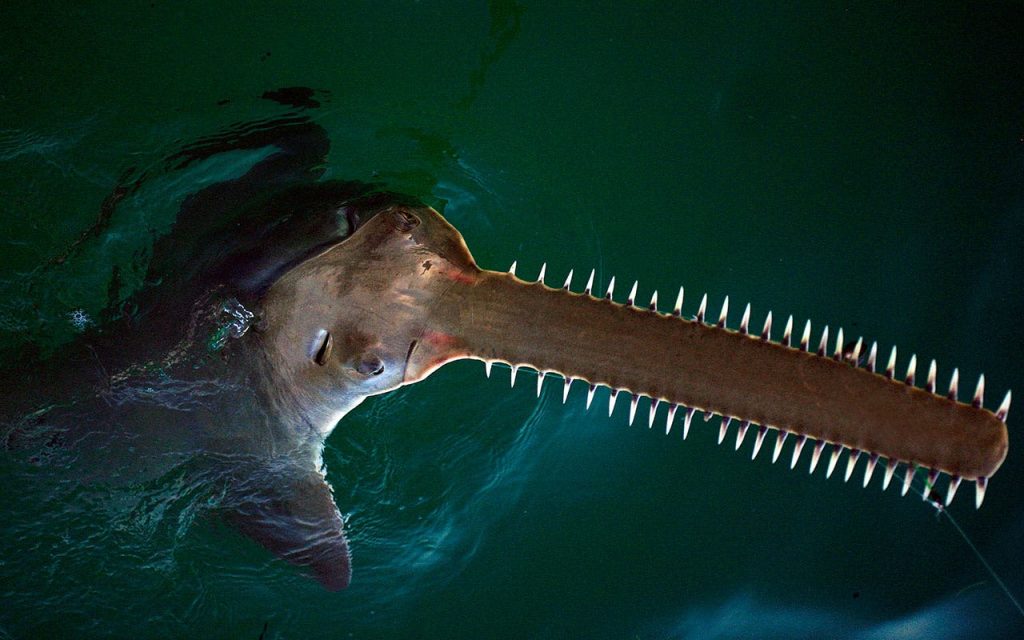The smalltooth sawfish, a species virtually unchanged for millions of years, is exhibiting unusual behavior and high mortality rates in Florida waters, prompting federal and state wildlife agencies to initiate a rescue and rehabilitation effort. The National Oceanic and Atmospheric Administration has announced an emergency response in the Florida Keys, labeling it unprecedented. These endangered marine creatures are showing erratic spinning behavior and are dying in unusual numbers. Efforts are being made to understand the cause of the sawfish distress and prevent further decline in their population.
Sawfish, related to rays, skates, and sharks, are named for their elongated, flat snout that contains a row of teeth on each side. They can live for decades and grow quite large, with some measuring as long as 16 feet. Once found all along the Gulf of Mexico and southern Atlantic coasts in the U.S., sawfish are now mainly in southwestern Florida and the Keys island chain due to shrinking habitats. The National Oceanic and Atmospheric Administration is working to rescue and rehabilitate sawfish from the wild for the first time ever, in an attempt to understand the recent distress and deaths among the population.
Since late January, state wildlife officials have documented an “unusual mortality event” among smalltooth sawfish, affecting about 109 individuals and resulting in at least 28 deaths. Reports indicate abnormal behavior, such as spinning or whirling in the water, not just among sawfish but also among other species. Necropsies conducted on deceased sawfish have not revealed any clear cause, and water testing is ongoing to identify any potential contaminants or factors contributing to the situation. The public is encouraged to report any sightings or information related to distressed or dead sawfish to aid in the rescue and rehabilitation efforts.
The recent heat wave affecting Florida waters, driven by climate change, may have contributed to the unusual behavior and deaths of smalltooth sawfish. Superheated waters have caused damage to marine life including coral bleaching and deaths of various species. The exact connection between the heat wave and the sawfish distress is unclear at this time, but remains an area of interest for researchers and wildlife agencies working to protect and conserve this endangered species. Efforts are ongoing to address the mystery surrounding the sawfish distress and prevent further harm to their population.
The collaboration between wildlife agencies and rehabilitation organizations, such as Mote Marine Laboratory and Aquarium, is crucial in rescuing and rehabilitating sawfish that are in distress. These organizations have facilities ready to accommodate rescued sawfish, providing necessary observation and care before release back into the wild. Even small numbers of sawfish deaths could have a significant impact on the population, listed as endangered since 2003. Public engagement and support are key to the success of these rescue efforts, with tips and sightings from the community helping rescuers locate and assist distressed sawfish.
In recent years, various marine species in Florida waters have faced challenges, including the threatened manatees who suffered a major die-off due to pollution killing their seagrass food source. State and federal officials intervened by feeding tons of lettuce to manatees to help sustain their population. The manatee numbers have shown signs of recovery, with a decrease in deaths recorded between 2021 and 2023. Similar support and intervention may be necessary to protect the smalltooth sawfish, whose population is vulnerable to environmental changes and human impacts. Through collaborative efforts and public engagement, the rescue and rehabilitation of these endangered marine creatures can help ensure their survival for future generations.


